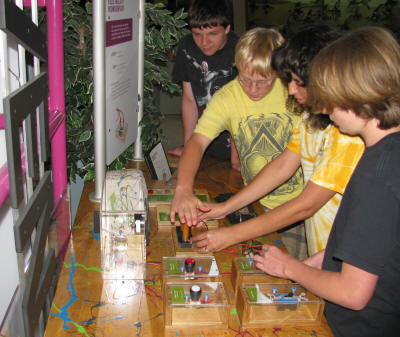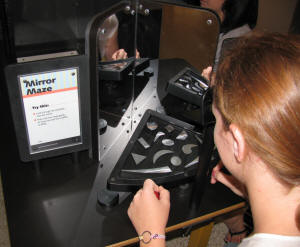University
Communications
Office
Arkansas State University
Jonesboro,
Arkansas
Staff
Markham Howe
Sara McNeil
Gina Bowman
(870) 972-3056
fax (870) 972-3693
More information:
NewsPage
Links to News Releases
& Announcements
KASU
Public Newsroom
KASU Local News
Campus Calendar
Public activities at ASU
About
ASU
Overview, history
and more |
ASU Museum presents two new
exhibitions in 'Summer of Science,' open now
June 1, 2010
--
Two new
exhibitions, now open at the Arkansas State University Museum, offer
great summer fun and l earning for families or for group field trips:
“Science and Art” and “Illusion Confusion.” “Science
and Art” features
artists integrating scientific principals into their art and includes
hands-on science activities. “Illusion Confusion” also offers hands-on
activities for children and adults, allowing them to learn more about
how perceptions can create illusions.
The ASU
Museum is located at 320 University Loop West Circle, Jonesboro, on the
campus of Arkansas State University. "Science and Art" closes Sunday,
August 29, while "Illusion Confusion" closes Sunday, September 26. earning for families or for group field trips:
“Science and Art” and “Illusion Confusion.” “Science
and Art” features
artists integrating scientific principals into their art and includes
hands-on science activities. “Illusion Confusion” also offers hands-on
activities for children and adults, allowing them to learn more about
how perceptions can create illusions.
The ASU
Museum is located at 320 University Loop West Circle, Jonesboro, on the
campus of Arkansas State University. "Science and Art" closes Sunday,
August 29, while "Illusion Confusion" closes Sunday, September 26.
“Science
and Art” includes the mathematical principals of origami; the physics,
mathematics, and computer science of 1-bit digital music; electrical
engineering and computer science in wearable art; and nanotechnology and
computer science in a multimedia interactive experience.
The work
of Robert Lang, PhD, one of the world’s leading
origami masters, shows
how following
simple folding rules and some basic
mathematical principals allows the creation of a complex and beautiful
3D world of art made from paper. An origami table allows visitors to
create their own works of art to take home.
Visitors will also enjoy the creations of
Tristan Perich, the inventor
of the project “1-Bit Music.” The 1-Bit Music project is part art, part
physics and part mathematics. Low-fidelity 1-bit compositions of
electronic music are delivered to listeners via an on/off switch,
microchip, battery, earphone jack, and volume control, all squeezed into
a plastic CD case. Teenagers will especially enjoy this exhibit as it
explores the music of the future and the scientific phenomenon of audio
frequency.
Wearable computers can also be found on display in “Science and Art.”
Leah Buechley, assistant professor at Massachusetts Institute of Technology
(MIT), uses electronics and textiles to build soft, wearable computers.
A display of Buechley’s “clubbing shirt” allows visitors to select and
see the different LED display patterns designed and programmed into the
shirt.
Rounding out the exhibit is electronic artist and computer scientist
Scott Snibbe, who introduces visitors to the concept of the nanoscale.
“Three Drops”
is a multimedia experience that invites participants to
move in front of a large screen and interact with projections of water
at the macroscale, the microscale and then the nanoscale level, thereby
allowing them to experience how the physical properties of water change
at these three different scales.
“Illusion
Confusion” plays with the sense of perception—things are not always as
they seem. Most
of the exhibit is hands-on, encouraging visitors to explore and play
with
 the perception of light and optical illusions. “Illusion Confusion”
investigates how light refracts and reflects and how mirrors and mazes
can create confusion or conflict with images. Visitors can laugh at
themselves and others in the anti-gravity mirror or guess at the
mysterious images. Visitors will seem to be able to lift both feet off
the ground and even to make their heads disappear. the perception of light and optical illusions. “Illusion Confusion”
investigates how light refracts and reflects and how mirrors and mazes
can create confusion or conflict with images. Visitors can laugh at
themselves and others in the anti-gravity mirror or guess at the
mysterious images. Visitors will seem to be able to lift both feet off
the ground and even to make their heads disappear.
“Science and Art” and “Illusion Confusion” are
both brought to the ASU Museum through its membership in the
Arkansas
Discovery Network, funded by the Donald W. Reynolds Foundation.
The ASU Museum is a great place to get out of the heat and spend some
quality family time this summer.
Treasure Hunts, available in the museum’s gift shop, are a fun way to
explore the museum; when visitors complete their maps, they select a
prize. The cost is $1.50 for the younger children’s Treasure Hunt, and
there is also a jewelry Treasure Hunt that is popular with teens and
tweens for $3-$5, depending on the number of visitors in the group.
The museum also offers
archeology-themed and western-themed birthday
parties for children;
reservations
are necessary. The ASU Museum is open Tuesday
from 9 a.m.-7 p.m.; Wednesday through Saturday from 9 a.m.-5 p.m. and
Sunday afternoon from 1-5 p.m. The museum is closed on Mondays and
university holidays, like Memorial Day. For more information, visit the
ASU Museum online
(http://www2.astate.edu/museum/), or call
Lenore Shoults
(lshoults@astate.edu),
assistant director, ASU Museum, at (870) 972-2074.
Photos, top and bottom:
Seventh-grade students from Sloan-Hendrix explore
the hands-on components of two science exhibitions currently open at
Arkansas State University Museum.
# # #
|
